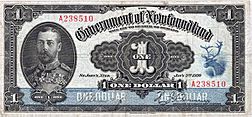Newfoundland dollar facts for kids
Quick facts for kids Newfoundland dollar |
|||
|---|---|---|---|
|
|||
| User(s) | |||
| Pegged with | Canadian dollar at par | ||
| Subunit | |||
| 1⁄100 | cent | ||
| Symbol | $ or NF$ | ||
| cent | ¢ | ||
| Coins | |||
| Banknotes |
|
||
The dollar was the money used in Newfoundland. It was used from 1865 until 1949. Back then, Newfoundland was a British colony and later its own country, called the Dominion of Newfoundland. In 1949, Newfoundland joined Canada and became a province. The Newfoundland dollar was divided into 100 cents.
Contents
History of the Newfoundland Dollar
In 1865, Newfoundland decided to use the gold standard. This meant their money's value was directly linked to a certain amount of gold. The dollar replaced the old money, called the Newfoundland pound. One dollar was worth 4 shillings and 2 pence of British money. This was slightly more than the Canadian dollar at the time.
This new system was a mix of British and American money ideas. It also made Newfoundland's dollar similar to the dollar used in some British Caribbean islands. These islands used a dollar that came from the old Spanish dollar. Newfoundland was special because it was the only part of the British Empire to make its own gold coins. These were two-dollar gold coins. They were made off and on until a big banking problem in 1894.
After the Newfoundland banking crash of 1894, Canadian banks started operating in Newfoundland. The value of the Newfoundland dollar was then changed. It was made equal to the Canadian dollar. This meant the Newfoundland dollar became worth a little less, about 1.4% less. When Newfoundland joined Canada in 1949, the Canadian dollar took over. One Newfoundland dollar was exchanged for one Canadian dollar.
Other British colonies in North America also started using a dollar system around this time. The small difference between the American dollar and the West Indian dollar was because of how the American dollar was first set up. In 1792, Alexander Hamilton looked at the average weight of old Spanish dollars. He used this to set the value of the new American money.
The Newfoundland dollar system was very similar to the dollar used in British Guiana. This was another British colony in South America. British Guiana also used a dollar system, but they still used British coins. Today, coins from the Newfoundland dollar are still valid money in all of Canada. Banknotes are also still legal to use.
Newfoundland Coins
Newfoundland started making its own coins in 1865. They made coins worth 1, 5, 10, and 20 cents. They also made a 2-dollar coin. The 1-cent coin was made of bronze. The 5, 10, and 20-cent coins were made of silver. The 2-dollar coin was made of gold. This gold coin was also sometimes called "Two Hundred Cents" or "One Hundred Pence."
In 1870, new silver 50-cent coins were made. In 1917, the 20-cent coin was replaced by a 25-cent coin. Later, in 1938, a smaller 1-cent coin was introduced.
Newfoundland Banknotes
In 1865, a bank called the Commercial Bank of Newfoundland started printing its own money. These notes showed values in both pounds and dollars. They used a rate of 4 dollars for 1 pound. This was the same rate used in Canada at the time. So, these notes might not have been meant for the Newfoundland dollar system.
In the 1880s, both the Commercial Bank and the Union Bank of Newfoundland printed notes. These notes only showed dollar values. They made notes for 2, 5, 10, 20, and 50 dollars. However, in 1894, both of these banks failed.
After the banks failed, the government stepped in. The Department of Public Works started issuing government cash notes in 1901. These notes came in values of 40, 50, and 80 cents, and 1 and 5 dollars. In 1910, they added 25-cent and 2-dollar notes. Later, in 1920, the Treasury department also printed 1- and 2-dollar notes.
Gold Standard and Its End
The Newfoundland dollar was connected to the Canadian dollar. It could also be exchanged for gold. This continued even after Canada stopped using the gold standard in April 1931. Because Canada left the gold standard, its money became weaker compared to the American dollar.
This created a chance for people to make money by exchanging currency. People could convert Canadian dollars into gold in Newfoundland. Then, they would take the gold to the United States and sell it for a profit. This made Newfoundland's gold supply start to shrink.
In December 1931, the Newfoundland government decided to stop using the gold standard. In 1932, a new law was passed. It said that gold could not be sent out of Newfoundland without special permission. Banknotes then became the official money. They could no longer be exchanged for gold. So, Newfoundland stopped using the gold standard about a year after Canada did.
See also




